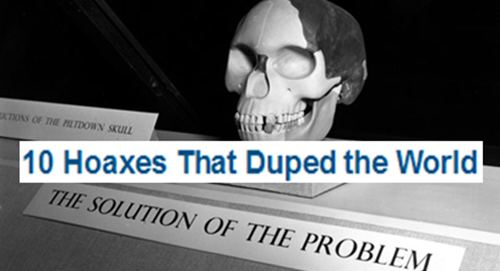
10 Crazy Hoaxes That Duped the World
By Melanie Radzicki McManus, How Stuff Works, 13 December 2012.
By Melanie Radzicki McManus, How Stuff Works, 13 December 2012.
You've probably seen the photo. Grainy and grey, it shows the neck and head of some type of large sea monster rising from the water - the freshwater of Scotland's Loch Ness. When the photo first appeared in 1933, many people believed it was real. After all, it was taken by Colonel Robert Wilson, a respected doctor, and stories of a monster in the loch had been swirling around Scotland for more than 1,400 years. But in 1994, the photo was exposed as a hoax. A man named Christian Spurling confessed that he, his stepfather and Wilson created it by attaching a piece of plastic to a toy submarine [source: Owen].
Many people, like "balloon boy" parents Richard and Mayumi Heene, create hoaxes
for attention.
Hoaxes have been around for centuries, created by people as jokes, or for profit or attention. And as crazy as some of them seem in hindsight, people are always willing to buy into them. Maybe believing in seemingly unbelievable things is part of the human psyche. Or maybe we just like to believe in whatever scientists and experts don't. Whatever the reason, don't think you'll never be fooled. Because sages and fools alike have been tricked by the following 10 hoaxes.
10. War of the Worlds Broadcast
Orson Welles narrated the War of the Worlds radio play.
In the 1930s, the world was drawing closer and closer to a second global war. Radio broadcasts were constantly being interrupted to bring news of what was happening near and far. Technology was also rapidly evolving, with space travel looming on the horizon. And science fiction was emerging as a literary genre. So maybe it wasn't too surprising when, on Oct. 30, 1938, thousands and thousands of Americans believed Martians were invading the United States. Why shouldn't they? They'd been listening to the radio, when the program was interrupted by a news bulletin that Martians had landed in New Jersey and were preparing to attack [source: Lovgen].
Panic ensued, as people tried to figure out whether, and where, to flee, and how to protect themselves from the poisonous gas the Martians were said to be releasing in New Jersey. People jammed the roads. Hid in their homes. Armed themselves. Some collapsed and received treatment for shock and hysteria [source: Lovgen].
But, of course, no Martians had landed. The program, narrated by writer-director Orson Welles, was merely a radio play based on H.G. Wells' 1898 book The War of the Worlds. Before the play began, CBS Radio announced it was a play based on Wells' novel. But many listeners had tuned in while the broadcast was in progress, and therefore missed the explanatory introduction. Some estimates say 20 percent of listeners believed in the invasion, or somewhere around 1 million people [source: Lovgen].
9. Escape of Anastasia Romanov
The Romanov family.
Who can resist the idea that somehow, some way, Grand Duchess Anastasia Nikolaevna Romanov escaped and lived to see another day? Anastasia was the youngest daughter of Czar Nicholas II and his wife, Alexandra. When Russia's Bolsheviks revolted in the early 20th century, they rounded up the Czar and his family and shot them all, execution style. Anastasia was 17.
For years following the slayings, people whispered Anastasia had escaped. Some said her brother, Alexei, had survived as well [source: Maugh II]. Then women began emerging in various spots around the globe, all claiming to be Anastasia. One woman, Anna Anderson, fought for 32 years - from 1938 to 1970 - to be legally recognized as the heir to the Romanov throne [source: Levy].
Then in 1991, a grave in Yekaterinburg was discovered that held nine bodies, including members of the Romanov family and their servants. But the bones of Alexei and one daughter were missing. Could it be that Anderson or another one of those female claimants really was Anastasia? Nope. In 2007, another grave was discovered near the Yekaterinberg one, and guess what it contained? The bones of two Romanov youngsters, a boy and girl [source: Maugh II].
8. Hitler's Diaries
Hitler may have penned secret diaries, but the ones unearthed in 1945 were fakes.
And you thought Anne Frank's diary was a big deal. In 1983, Der Stern, a German newsweekly publication, proclaimed one of its investigative reporters, Gerd Heidemann, had stumbled upon a set of secret diaries penned by none other than Adolf Hitler. The precious manuscripts had apparently been stashed away for decades by a "Dr. Fischer" after they were discovered near a Dresden-area plane crash in 1945 [source: Levy].
Before Der Stern published this bombshell, it did subject the diaries to three separate handwriting tests for authentication, and the tests had come back positive. But the magazine didn't conduct any other tests, probably because they were so anxious to publish such a major scoop - and profit from it by selling reprint rights to other publications [source: UnMuseum].
When the news broke, German World War II experts (and sceptics) pored over the diaries. West Germany's Federal Archives also ran scientific tests on them. Der Stern had been tricked. The researchers found numerous historical inaccuracies in the documents, while the Federal Archive tests proved they were created with modern-day paper and ink [source: UnMuseum].
Konrad Kujau, an infamous Stuttgart forger, was revealed as the hoaxer. Heidemann was somehow in on it, too, although no one knows the exact arrangement between the two. But both profited from the estimated $4 to $6 million Der Stern had forked over for the diaries. Kujau, his wife and Heidemann ended up in the clink for forgery and embezzlement [sources: Levy, UnMuseum].
7. Georgia Under Attack
A 2008 Imedi broadcast stating that Georgia's leader Mikheil Saakashvili had been
assassinated sent citizens pouring into the streets in a panic.
Russian tanks rolled into former Soviet Georgia in 2008, supposedly to protect the Russian nationals living in South Ossetia, a Georgian province. South Ossetia was home to an antsy separatist movement, and Georgia had sent in troops to maintain control. Not surprisingly, they weren't happy Russia was interfering in their business, and called Russia's actions aggressive and hostile [source: The Telegraph]. A five-day war ensued, with Georgia squaring off against Russia and South Ossetia. The result? Georgia lost control of South Ossetia and an area called Abkhazia [source: Harding].
Less than two years later, Georgians were terrified when the pro-government TV station Imedi interrupted prime-time viewing one Saturday night to report the Russians were back. The station went on to report that Georgia's pro-Western leader, Mikheil Saakashvili, had been assassinated [source: Levy].
Georgians ran out into the streets screaming. The country's cell phone network went down. People ended up in the hospital, suffering from acute stress. One woman reportedly had a heart attack and died. In Russia, state news agency Interfax jumped on the Georgians' announcement, sending out a quick report about the invasion and Saakashvili's death [source: Levy].
Thirty minutes later, former reporter David Cracknell, now a Georgian governmental employee, uncovered the truth: There was no invasion, and Saakashvili was alive. Apparently the fake broadcast was made to simulate what might happen in Georgia if Russia once again did invade and the citizens were so warned. Imedi claimed announcers had noted it was merely a hypothetical scenario before the broadcast, but most viewers didn't pick up on that [source: Harding].
6. Cardiff Giant
A stonecutter carved the Cardiff Giant out of a slab of gypsum.
In 1868, atheist George Hull hired a stonecutter to carve a slab of gypsum into a 10-foot-tall man with 21-inch-long feet. He then had it buried on the farm of distant-relative William Newell in Cardiff, New York. [sources: Brown, The Skeptic's Dictionary]. The following year, workers digging a well on the property discovered the stone man, and people all over were quickly enthralled [source: Radford]. Was it an ancient carving? Or a fossilized giant? If it was the latter, some said, it was proof the Bible was literally true, for Genesis 6:4 says, "There were giants in the earth in those days..." [source: Radford].
Experts smelled a rat, and tried to warn people not to get too excited. But it was too late. People flocked to the remote farm site - hundreds and even thousands per day - paying 50 cents a head (a whole lot of money in those days) to see "Goliath." Even more amusing, P.T. Barnum quickly created a duplicate which people paid to see, thinking it was the original. So they were double-duped [sources: The Skeptic's Dictionary, Brown].
Hull created the behemoth as a practical joke, and also to make those who believed in a literal interpretation of the Bible look foolish [source: Radford]. He confessed after an associate sued Barnum for claiming Barnum's giant was the original one [source: Brown]. The fake fossil is still around for viewing at the Farmer's Museum in Cooperstown, New York. [source: The Skeptic's Dictionary].
5. Piltdown Man
The jaw of the Piltdown skull turned out to be from an orangutan whose teeth were filed
to match human wear patterns.
The minute Darwin published his theory of evolution in 1859, scientists began frantically searching for the "missing link." Some kind of fossil from a transitional creature in between a full ape and full man. Someone in the midst of evolving. In 1912, Englishman Charles Dawson claimed he'd found it - eureka! - in a gravel pit in a place called Piltdown [source: Bartlett].
Taking the fossils they'd found, Dawson and a colleague recreated a skull with a human-sized brain and apelike jaw. The skull was dubbed Piltdown Man. England merrily celebrated its new status as the birthplace of modern man. But some scientists cried foul. The skull didn't match other finds around the world, namely the famed Australopithecines fossil discovered in South Africa. Dawson then announced in 1915 that he'd found another fossil similar to Piltdown Man. With evidence of two Piltdowns, most people believed the hoax [source: Bartlett].
Piltdown Man's demise occurred in 1953, when British scientists, using new technology, dated his remains at 500 years old - not the 1 million necessary to be the missing link. They also discovered his jaw was from an orangutan whose teeth were filed to match human wear patterns. All of the fossils had been stained to match each other. Piltdown Man wasn't just an erroneously identified find, it was a hoax [source: Bartlett].
We'll never know who perpetrated the hoax, as most of the folks involved were dead by the time the truth was revealed. One intriguing suspect is Sir Arthur Conan Doyle, author of the Sherlock Holmes books. Doyle lived near Piltdown, was a member of the same archaeological society as Dawson and was into spiritualism, which scientists mocked. Perhaps this was his way of getting back at them [source: Bartlett].
4. Cottingley Fairies
Sir Arthur Conan Doyle's interest helped turn the Cottingley fairies into a
worldwide phenomenon.
In 1917, when Elsie Wright and her cousin, Frances Griffiths, were kids living near Cottingley, England, they wanted to prove fairies existed. So they took a few photographs of each other with fairies dancing around them. Elsie had drawn the paper cut-outs, and the two used hatpins to invisibly set them in place. The girls' parents assumed they were trick photos, although the girls refused to admit it [source: Coppens].
Their fairy tale would have been nothing but a harmless home prank, except Sir Arthur Conan Doyle - a possible culprit in the previous hoax - heard about the photos. Doyle was a big believer in fairies, and was about to write an article about them. He viewed the photos and mentioned them in his article. Soon people all over the world were viewing the girls' photos and excited to learn of the existence of fairies [source: Coppens].
The cousins stuck to their story for decades, only admitting the photos had been faked in the 1980s, when they were old and long retired. Today, people still travel to Cottingley to see the glen where the fairies were once photographed [source: Coppens].
3. Fiji Mermaid
P.T. Barnum, depicted in this illustration, operated a 19th-century sideshow full of
curiosities like the Fiji Mermaid.
There's a sucker born every minute, as P.T. Barnum is famed for proclaiming. (Although someone else actually said it. But that's another story.) Barnum, a circus operator and huckster, operated a popular, 19th-century sideshow of "curiosities, freaks and oddities." Many of the people and objects in his sideshow were real: the Fat Lady, the little person Tom Thumb, the Bearded Lady. Then, in 1842, he included the Fiji Mermaid in his sideshow. The Fiji Mermaid, Barnum said, was the mummified remains of a real mermaid [source: TruTV].
People came, saw and believed. But a few sceptics were out there, and they dug around until they found out the truth - Barnum was a liar. Gasp! The Fiji Mermaid wasn't a deceased sea maiden after all. She wasn't even necessarily a she. Barnum had simply attached the head and torso of a baby monkey onto the tail of a fish, then covered the whole thing in papier-mâché [source: TruTV]. Kinda gross, really.
2. Balloon Boy
Little Falcon Heene let the cat out of the bag about his parents' hoax.
On Oct. 15, 2009, the world was riveted as images of a giant, homemade weather balloon floating through the skies - presumably with a 6-year-old boy huddled inside - flashed across their TV screens. Parents Richard and Mayumi Heene tearfully told authorities they'd created the silver, saucer-like helium balloon, launched it from their home in Fort Collins, Colorado, then noticed their son, Falcon, was missing. They searched their home, calling out for him everywhere, and realized with a sinking feeling that Falcon may have climbed inside the balloon's compartment when they weren't looking.
For 50 minutes, the balloon - which intriguingly resembled a UFO - floated around the Colorado skies while authorities frantically tracked it in an effort to get Falcon safely back on terra firma. The Federal Aviation Administration even suspended some departures from Denver International Airport during the debacle [source: Hughes and Bazar].
The balloon eventually landed, but Falcon wasn't inside after all. He was later discovered hiding in the family's attic. A media frenzy surrounded the Heenes, but only until their hoax was discovered, thanks to the honesty of little Falcon. Falcon and his parents were on CNN's "Larry King Live" when Falcon said the reason he didn't come out from his hiding spot in the attic when his parents were looking for him was because his parents had told him not to. The family, which had previously appeared on the reality show "Wife Swap," had devised the balloon incident in the hopes it would interest TV producers in creating a reality show about them [source: CNN].
1. Mary Toft's Bunny Births
A popular 18th-century broadsheet illustrated what went down during the Mary Toft hoax.
One of the most amazing (and gross) hoaxes of all time took place in England in 1726. That's when Mary Toft, a servant from Godalming, in Surrey, went into labour and delivered some animal parts. Local obstetrician John Howard was called in, and, over the next month, he helped deliver a rabbit's head, the legs of a cat and nine dead baby rabbits, the latter all in one day. Soon everyone from a Swiss surgeon-anatomist to the Prince of Wales' secretary visited Toft, who had become local celebrity, to witness the unbelievable births. And unbelievable they deemed them to be [source: University of Glasgow].
After examining one of the rabbits, a German surgeon found corn, hay and straw in its dung, proving it couldn't have developed inside Toft. Others reached the same conclusion after studying the bunnies' lungs and other organs. A porter was then caught trying to smuggle a rabbit into Toft 's room. Eventually Toft confessed she'd been inserting the rabbits and other animal parts into her vagina, then letting the various physicians "deliver" them [source: University of Glasgow].
Why in the world would she do this? Toft was poor, and in 18th-century Europe, people eagerly paid money to see human oddities and deformities. Her stunt was an effort to earn money and live a life of relative ease [source: Curry, Morris, Samuels and Shrout, University of Glasgow].
Author's Note: I don't think I've ever fallen for a hoax. But I did always want to believe that Anastasia was alive somewhere. Especially after seeing the animated movie.
Article Sources:
1. Bartlett, Kate. "Piltdown Man: Britain's Greatest Hoax." BBC. Feb. 17, 2011. (Nov. 13, 2012)
2. Brown, R.J. "P.T. Barnum Never Did Say 'There's a Sucker Born Every Minute.'" History Buff. (Nov. 19, 2012)
3. CNN. "Authorities: 'Balloon boy' incident was a hoax." Oct. 19, 2009. (Nov. 13, 2012)
4. Coppens, Philip. "Fairy dust: the Cottingley Fairies." Philip Coppens. (Nov. 18, 2012)
5. Cottingley. "Cottingley Fairies." (Nov. 13, 2012)
6. Curry, Andrew and Holly Morris, Art Samuels and Maggie Shrout. "Hoaxes of the ages." U.S. News. (Nov. 18, 2012)
7. Harding, Luke. "Russian invasion scare sweeps Georgia after TV hoax." The Guardian. March 14, 2010. (Nov. 19, 2012)
8. Hughes, Trevor and Emily Bazar. "Lawyer: Family in balloon incident 'under siege.'" USA Today. Oct. 19, 2009. (Nov. 19, 2012)
9. Levy, Glen. "Georgia On Everyone's Mind." Time. March 16, 2010. (Nov. 13, 2012)
10. Levy, Glen. "Hitler's Diaries." Time. March 16, 2010. (Nov. 13, 2012)
11. Levy, Glen. "The Last of the Romanovs." Time. March 16, 2010. (Nov. 13, 2012)
12. Lovgen, Stefan. "'War of the Worlds': Behind the 1938 Radio Show Panic." National Geographic News. June 17, 2005. (Nov. 13, 2012)
13. Maugh II, Thomas. "DNA testing ends mystery surrounding Czar Nicholas II children." LA Times. March 11, 2009. (Nov. 19, 2012)
14. Mother Nature Network. "Hoaxes: Fiji mermaid." (Nov. 13, 2012)
15. Owen, James. "Loch Ness Sea Monster Fossil a Hoax, Say Scientists." National Geographic News. July 29, 2003. (Dec. 4, 2012)
16. Radford, Benjamin. "Article: The World's Greatest Hoaxes." Live Science. Oct. 19, 2009. (Nov. 13, 2012)
17. Radford, Benjamin. "New Nessie Photo: 'Convincing' Proof of Loch Ness Monster?" Live Science. Aug. 3, 2012. (Nov. 19, 2012)
18. The Skeptic's Dictionary. "Cardiff giant." Dec. 9, 2010. (Nov. 13, 2012)
19. The Telegraph. "Russia 'invades' Georgia, as South Ossetia descends towards war." Aug. 8, 2008. (Nov. 19, 2012)
20. TruTV. "Top 10 Paranormal 'Hoaxes' Of All Time." (Nov. 13, 2012)
21. UnMuseum. "The Hitler Diaries." (Nov. 19, 2012)
22. University of Glasgow Library Special Collections Department. "The Curious Case of Mary Toft." August 2009. (Nov. 13, 2012)
Related Articles:



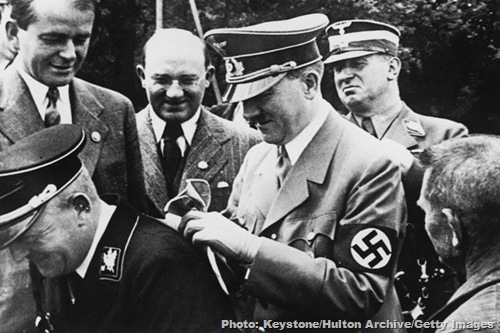

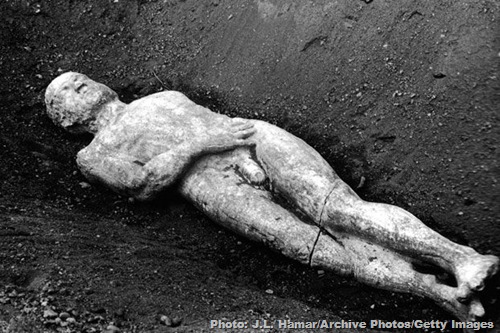

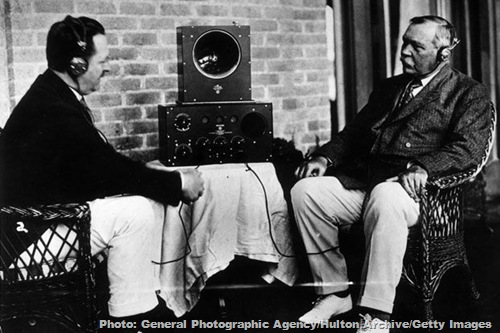
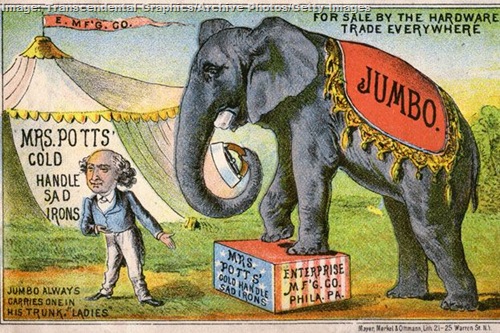

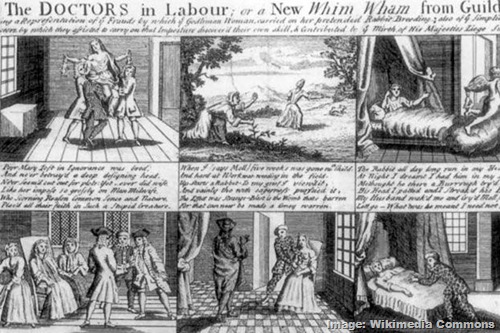
No comments:
Post a Comment
Please adhere to proper blog etiquette when posting your comments. This blog owner will exercise his absolution discretion in allowing or rejecting any comments that are deemed seditious, defamatory, libelous, racist, vulgar, insulting, and other remarks that exhibit similar characteristics. If you insist on using anonymous comments, please write your name or other IDs at the end of your message.